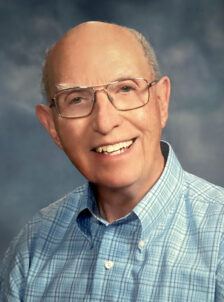
October 1, 1930 – September 29, 2024
Family and friends mourn the loss of Charles Hebel and gratefully celebrate his life.
“Chuck,” to family and friends, was a Renaissance man—a beloved family leader, versatile scientist, and engaged community member—who lived a full life of creativity, service, and love, passing away peacefully after a brief illness.
Chuck especially enjoyed his children and grandchildren, relating to them as peers. He built treasured memories with them by reading to them, supporting their education, celebrating their accomplishments, taking them on adventures, and generously sharing his time and goofy sense of humor.
Born in Oak Park, Illinois, he grew up in Lombard, then on Chicago’s pastoral outskirts, surrounded by open fields and rivers where he and his brother explored and fished. His gifts for science and technology revealed themselves early in his experimenting with his chemistry set and building radios as a young child.
Chuck attended De Pauw University in Greencastle Indiana, intending to pursue chemistry. Instead, he fell in love with physics there. He also fell in love with his future wife, Greencastle native and virtuoso organ student Virginia Arnold, brought together in the college band by their love of music.
As a graduate student at the University of Illinois, then a solid-state-physics hotbed, he joined renowned physicist John Bardeen’s team developing the “BCS Theory” of superconductivity which earned Bardeen a second Nobel Prize. Chuck’s doctoral research, in supercooled aluminum, discovered the Hebel-Schlichter Effect which helped confirm the theory. Meanwhile, he and Virginia married and started a family, beginning a loving life together that would flourish for more than 50 years.
The success and publication of Chuck’s research in 1957 led to his hiring by Bell Labs in New Jersey. It was there that he discovered his talent for guiding and supporting researchers and research programs, the role that would focus his scientific career. He was also named director of research into ICBM re-entry, which took him to Kwajalein Atoll in the Marshall Islands in the first of many national roles. Outside of the lab, mentoring in a public-school program for gifted students and serving as a local Scout Master launched his life of volunteerism.
In 1968, Chuck moved his young family to Albuquerque, where he served as director of research at Sandia National Laboratory, creating a time of wonder for the family exploring New Mexico’s dramatic natural environment and rich indigenous cultures. There he served as Scout Master of his older son’s troop and led them on backpacking treks across the Sangre de Cristo Mountains.
In 1973, he returned to the private sector to manage research and later oversee patenting for Xerox, initially in Rochester, and then moving to Cupertino to finish at PARC in Palo Alto. Xerox often loaned out his talents to lead federal studies managed by the American Physical Society on topics including nuclear reactor safety, anti-missile technologies, nuclear waste disposal, and nuclear-fusion energy generation. This work extended beyond the laboratory to service as US representative and Deputy to the Ambassador at Large in the State Department’s nuclear non-proliferation initiatives, including international fuel-cycle security and the SALT II treaty. Chuck retired in the 1990’s to care for Virginia in her long battle with cancer that ended in 2004.
In Cupertino, Chuck expanded his artwork, community service, and philanthropy, especially after the last of his three children went off to college. He served as Scout Master and backpacking leader of his younger son’s troop, and then as District Commissioner, earning Scouting’s Silver Beaver award for lifetime service. He engaged intensively in his lifelong passion for photography, including a master class with Ansel Adams. After Virginia passed away at El Camino Hospital, he volunteered in its auxiliary, which he soon led, contributing 8,000 hours over 15 years. During that time, he also participated in community service programs of the First United Methodist Church of Palo Alto, where he was a member, and travelled to volunteer constructing buildings at a Methodist mission in Kenya.
After Virginia passed away, Chuck moved to Palo Alto’s Channing House and began a new chapter in his life, participating vigorously in that community’s rich social and cultural life while singing tenor in church choirs and the Bay Choral Guild and reviving his clarinet playing as a member of a local chamber ensemble. At Channing, he met resident Joy Sleizer and they began a wonderful 13-year loving partnership that he and both their families treasured. He and Joy shared their mutual love of the arts, by frequenting San Franscisco’s Museum of Modern Art, Opera, and Ballet, and their mutual love of travel.
Chuck is survived by his partner Joy, sister Jane Hebel in Chicago, and three children—Howard, a retired architect in Connecticut, Janet Porter, a nurse in North Carolina, and Glenn, a doctor in New Hampshire—as well as nine grandchildren (including a set of triplets) and one great grandchild on the way. He was predeceased by his wife Virginia and brother Richard.
Chuck was a member of the American Association for the Advancement of Science and the New York Academy of Sciences, a Fellow of the American Physical Society, and a Visiting Scholar and Adjunct Fellow at the Stanford Center for International Security & Arms Control.
The Channing House community celebrated Chuck’s life in August with a gathering and an exhibition of his black and white photography. A memorial will be held soon at a time to be announced. His family will inter his ashes later this year in Greencastle, Indiana, next to Virginia and her parents.
In lieu of flowers, the family requests that donations in Chuck’s memory be made to El Camino Hospital and Church World Service.
